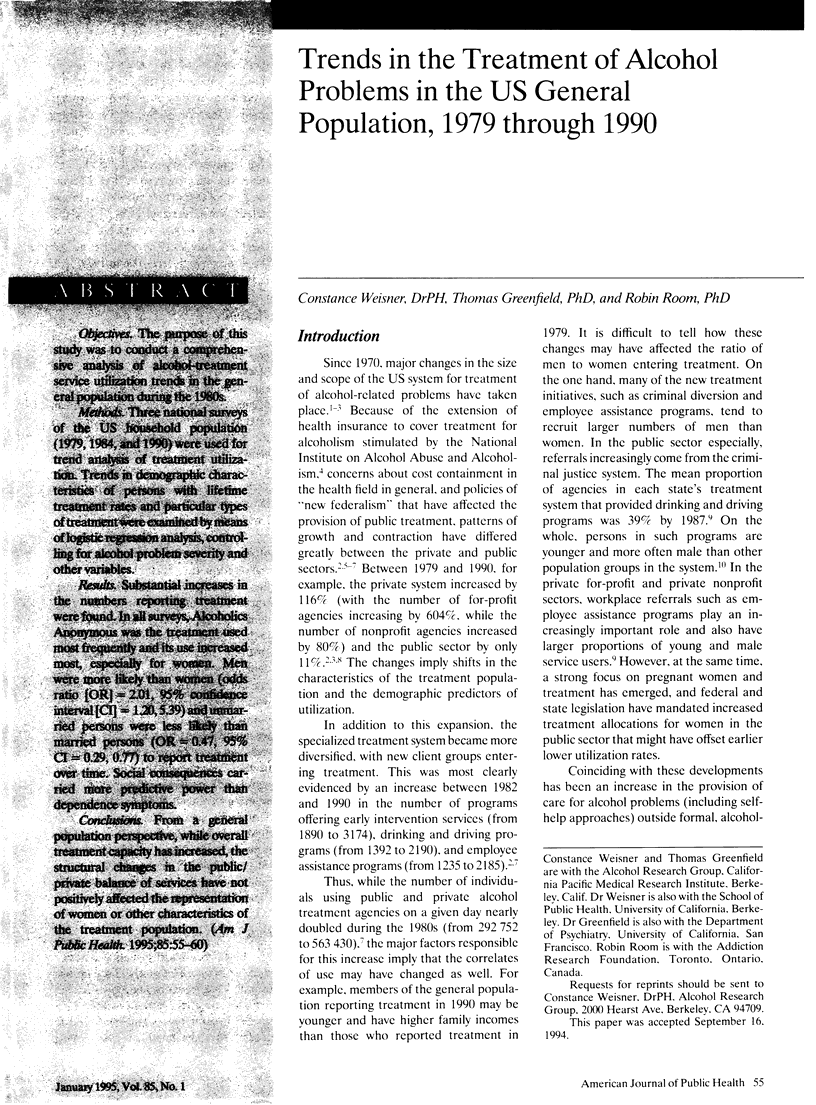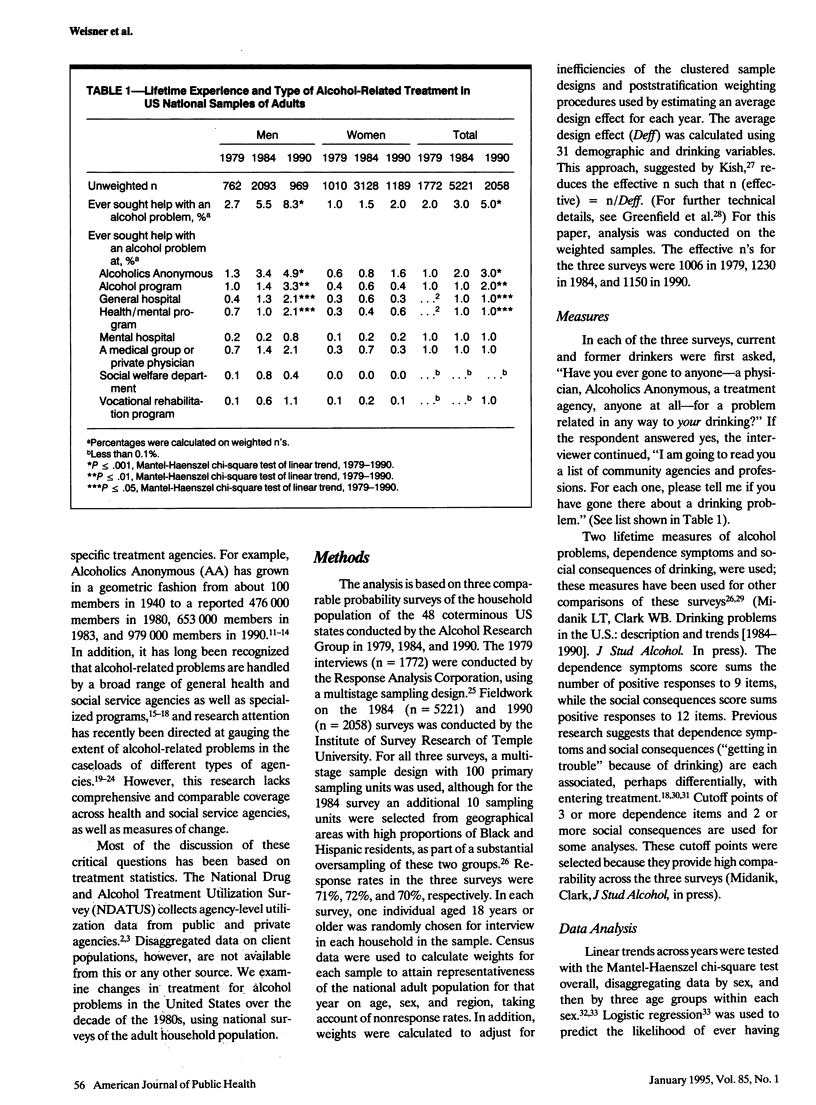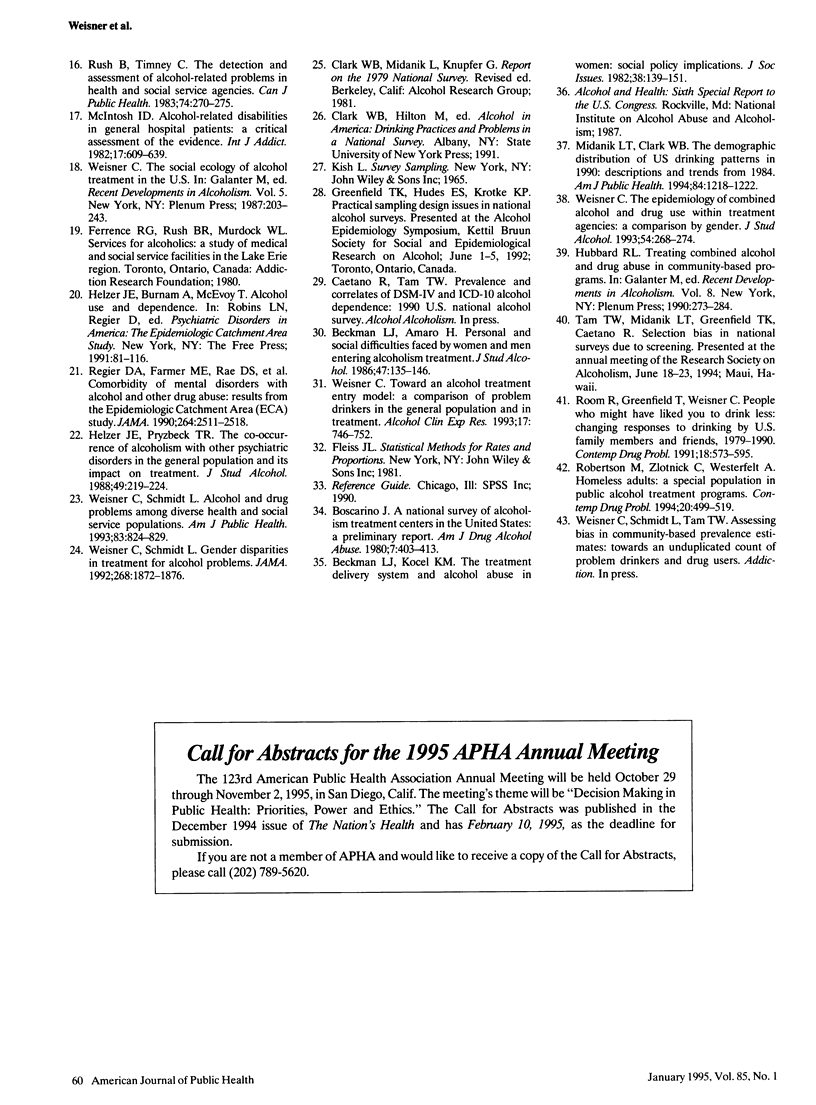Abstract
OBJECTIVES. The purpose of this study was to conduct a comprehensive analysis of alcohol-treatment service utilization trends in the general population during the 1980s. METHODS. Three national surveys of the US household population (1979, 1984, and 1990) were used for trend analysis of treatment utilization. Trends in demographic characteristics of persons with lifetime treatment rates and particular types of treatment were examined by means of logistic regression analysis, controlling for alcohol problem severity and other variables. RESULTS. Substantial increases in the numbers reporting treatment were found. In all surveys, Alcoholics Anonymous was the treatment used most frequently and its use increased most, especially for women. Men were more likely than women (odds ratio [OR] = 2.01, 95% confidence interval [CI] = 1.20, 5.39) and unmarried persons were twice as likely as married persons to have been treated [corrected]. Social consequences carried more predictive power than dependence symptoms. CONCLUSIONS. From a general population perspective, while overall treatment capacity has increased, the structural changes in the public/private balance of services have not positively affected the representation of women or other characteristics of the treatment population.
Full text
PDF





Selected References
These references are in PubMed. This may not be the complete list of references from this article.
- Beckman L. J., Amaro H. Personal and social difficulties faced by women and men entering alcoholism treatment. J Stud Alcohol. 1986 Mar;47(2):135–145. doi: 10.15288/jsa.1986.47.135. [DOI] [PubMed] [Google Scholar]
- Boscarino J. A national survey of Alcoholism Treatment Centers in the United States--a preliminary report. Am J Drug Alcohol Abuse. 1980;7(3-4):403–411. doi: 10.3109/00952998008993436. [DOI] [PubMed] [Google Scholar]
- Helzer J. E., Pryzbeck T. R. The co-occurrence of alcoholism with other psychiatric disorders in the general population and its impact on treatment. J Stud Alcohol. 1988 May;49(3):219–224. doi: 10.15288/jsa.1988.49.219. [DOI] [PubMed] [Google Scholar]
- Hubbard R. L. Treating combined alcohol and drug abuse in community-based programs. Recent Dev Alcohol. 1990;8:273–283. [PubMed] [Google Scholar]
- McIntosh I. D. Alcohol-related disabilities in general hospital patients: a critical assessment of the evidence. Int J Addict. 1982 May;17(4):609–639. doi: 10.3109/10826088209053007. [DOI] [PubMed] [Google Scholar]
- Midanik L. T., Clark W. B. The demographic distribution of US drinking patterns in 1990: description and trends from 1984. Am J Public Health. 1994 Aug;84(8):1218–1222. doi: 10.2105/ajph.84.8.1218. [DOI] [PMC free article] [PubMed] [Google Scholar]
- Moore R. D., Bone L. R., Geller G., Mamon J. A., Stokes E. J., Levine D. M. Prevalence, detection, and treatment of alcoholism in hospitalized patients. JAMA. 1989 Jan 20;261(3):403–407. [PubMed] [Google Scholar]
- Regier D. A., Farmer M. E., Rae D. S., Locke B. Z., Keith S. J., Judd L. L., Goodwin F. K. Comorbidity of mental disorders with alcohol and other drug abuse. Results from the Epidemiologic Catchment Area (ECA) Study. JAMA. 1990 Nov 21;264(19):2511–2518. [PubMed] [Google Scholar]
- Roman P. M. Growth and transformation in workplace alcoholism programming. Recent Dev Alcohol. 1988;6:131–158. doi: 10.1007/978-1-4615-7718-8_7. [DOI] [PubMed] [Google Scholar]
- Room R., Greenfield T. Alcoholics anonymous, other 12-step movements and psychotherapy in the US population, 1990. Addiction. 1993 Apr;88(4):555–562. doi: 10.1111/j.1360-0443.1993.tb02062.x. [DOI] [PubMed] [Google Scholar]
- Rush B., Timney C. The detection and assessment of alcohol-related problems in health and social service agencies. Can J Public Health. 1983 Jul-Aug;74(4):270–275. [PubMed] [Google Scholar]
- Schmidt L., Weisner C. Developments in alcoholism treatment. Recent Dev Alcohol. 1993;11:369–396. doi: 10.1007/978-1-4899-1742-3_20. [DOI] [PubMed] [Google Scholar]
- Weisner C., Schmidt L. Alcohol and drug problems among diverse health and social service populations. Am J Public Health. 1993 Jun;83(6):824–829. doi: 10.2105/ajph.83.6.824. [DOI] [PMC free article] [PubMed] [Google Scholar]
- Weisner C., Schmidt L. Gender disparities in treatment for alcohol problems. JAMA. 1992 Oct 14;268(14):1872–1876. [PubMed] [Google Scholar]
- Weisner C. The epidemiology of combined alcohol and drug use within treatment agencies: a comparison by gender. J Stud Alcohol. 1993 May;54(3):268–274. doi: 10.15288/jsa.1993.54.268. [DOI] [PubMed] [Google Scholar]
- Weisner C. Toward an alcohol treatment entry model: a comparison of problem drinkers in the general population and in treatment. Alcohol Clin Exp Res. 1993 Aug;17(4):746–752. doi: 10.1111/j.1530-0277.1993.tb00833.x. [DOI] [PubMed] [Google Scholar]
- Yahr H. T. A national comparison of public- and private-sector alcoholism treatment delivery system characteristics. J Stud Alcohol. 1988 May;49(3):233–239. doi: 10.15288/jsa.1988.49.233. [DOI] [PubMed] [Google Scholar]


